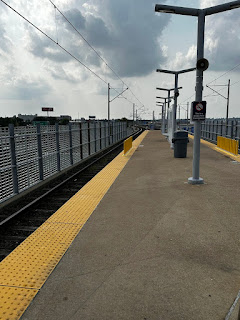I revisited St. Louis not long ago and took the opportunity to ride the MetroLink, which I had not done in a few years. MetroLink is the region’s one-line (with branches) light rail system, which serves several important destinations, including the airport, the University of Missouri at St. Louis, and downtown St. Louis. As I was headed to the ballpark, which has its own station, it was especially convenient for me.
The good news is that the line worked fine, with clean cars and a smooth ride. What was not so good was some of the stations. And the impact on the surrounding urban fabric was disappointing.
I’ll mention a few of the stations.
Airport
There may have been an easier way to get there, but I found myself traversing an underground parking garage and going up an elevator which looked like it hadn’t been cleaned in 10 years. The station platform was spartan and was inhabited by a homeless man who was busy checking out the platform for any usable refuse. And the headway between trains was 30 minutes, at least twice as long as it should be. In fairness, the transit agency is no doubt starved for operations and maintenance funding and does the best it can. (Not good enough, America!) Photo below.
Wellston
Missouri’s poorest, nearly all minority town, Wellston is fortunate enough to have a MetroLink
station near the center of town with lots of clear space around it. What an opportunity for public
investment in mixed-use development that could spur revitalization! But this is Missouri, so it’s
not happening. Photo below.
Central West End
Not much to see here at the station, which is in a cut, but a great location convenient to the
vibrant, mixed-use Central West End neighborhood.
Cortex
This is an infill station, built to serve the burgeoning “Cortex Innovation District.” Great idea,
but couldn’t something be done at the station to make a more appealing pedestrian connection?
Photo below.
Stadium
Again, pretty basic station in a cut. The station and neighborhood are very lively during
St. Louis Cardinals game days, perhaps not so much at other times (a nearby sign reminds
people that public urination is illegal). The area itself – Busch Stadium, Ballpark Village –
still looks good, but I didn’t see signs of urban revitalization spreading very far.
Photos below.
8th and Pine
This is the central downtown station, as well as one of the main access points via
transit to the Gateway Arch. I wasn’t in the station itself (now closed for renovation) but
I have to say that the surrounding area is a bit scruffy. Adjacent to the station is the
Wainwright Building, an architectural gem, which should be the centerpiece of transit
oriented development at this location. Ideally, that development would include taking
down the ugly 1980s annex, which is fronted by garage doors, and replacing it with a
plaza of some sort. The Wainwright Building has been occupied by state offices, but the
benighted state leadership has decided to sell off the building and move all 600 state
employees to an exurban office park. (How much do Missouri Republicans hate cities
and transit?) Fortunately, the building has been purchased, and we can hope for proper
redevelopment (story here). Photo below.
So, not much visible progress in transit-oriented redevelopment since my last visit a few
years ago. But the light rail line still purrs right along, there are plans for expansion (good
luck with the funding), and lots of raw opportunity in what was once – and could be again –
one of America’s premier cities






